PONTIAC BONNEVILLE 1994 Workshop Manual
Manufacturer: PONTIAC, Model Year: 1994, Model line: BONNEVILLE, Model: PONTIAC BONNEVILLE 1994Pages: 290, PDF Size: 14.75 MB
Page 51 of 290
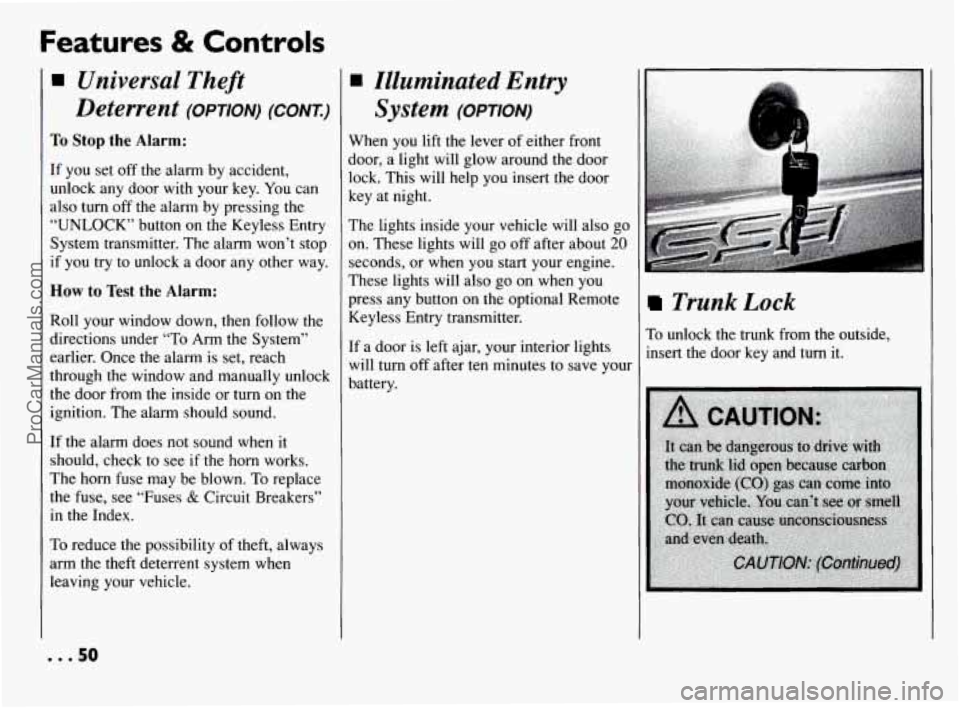
Features & Controls
Universal Theft
Deterrent
(omoN) (CONI)
To Stop the Alarm:
If you set off the alarm by accident,
unlock any door with your key.
You can
also
turn off the alarm by pressing the
“UNLOCK” button on the Keyless Entry
System transmitter. The alarm won’t stop
if you try to unlock a door any other way.
How to Test the Alarm:
Roll your window down, then follow the
directions under
“To Arm the System”
earlier. Once the alarm is set, reach
through the window and manually unlock
the door from the inside or
turn on the
ignition. The alarm should sound.
If the alarm does not sound when it
should, check to see
if the horn works.
The horn fuse may be blown. To replace
the fuse, see “Fuses
& Circuit Breakers”
in the Index.
To reduce the possibility
of theft, always
arm the theft deterrent system
when
leaving your vehicle.
H Illuminated Entry
System
(omoN)
When you lift the lever of either front
door, a light will glow around the door
lock. This will help you insert the door
key at night.
The lights inside your vehicle will also
go
on. These lights will go off after about 20
seconds, or when you start your engine.
These lights will also
go on when you
press any button on the optional Remote
Keyless Entry transmitter.
If a door is left ajar, your interior lights
will turn
off after ten minutes to save your
battery.
Trunk Lock
To unlock the trunk from the outside, insert the door key and
turn it.
... 50
ProCarManuals.com
Page 52 of 290
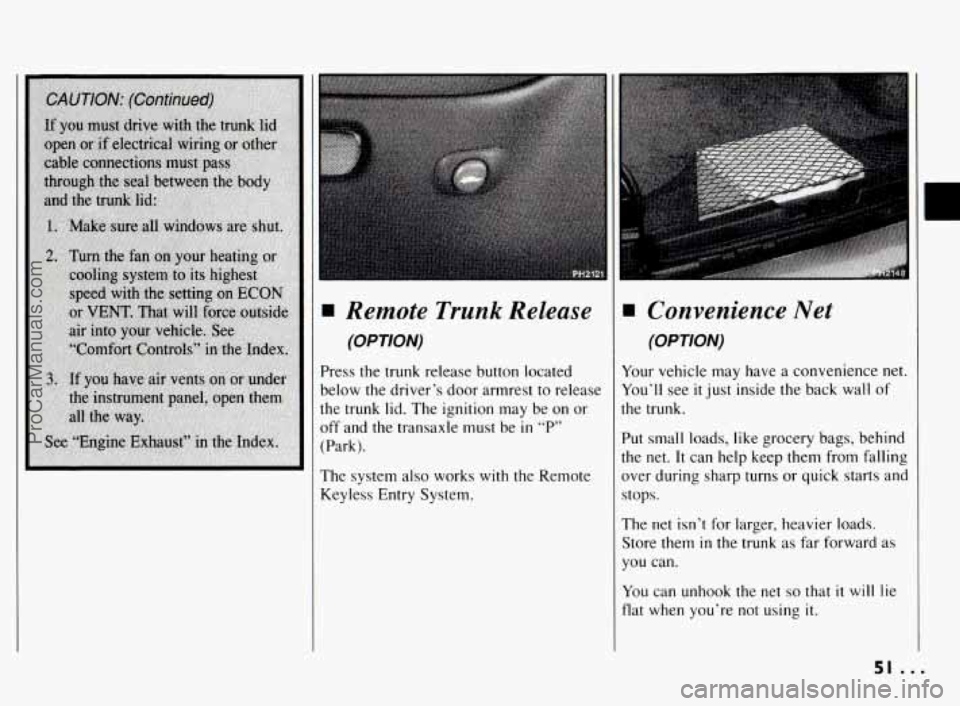
I
Remote Trunk Release
(OPTION)
Press the trunk release button located
below the driver’s door armrest to release
the trunk lid. The ignition may be on or
off and the transaxle
must be in “P”
(Park).
The system also works
with the Remote
Keyless Entry System.
Convenience Net
(OPTION)
Your vehicle may have a convenience net.
You’ll see
it just inside the back wall of
the trunk.
Put small loads, like grocery bags, behind
the net.
It can help keep them from falling
over during sharp turns or quick starts and
stops.
The net isn’t for larger, heavier loads.
Store them
in the trunk as far forward as
you can.
You can unhook the net
so that it will lie
flat when you’re not using
it.
51 ...
ProCarManuals.com
Page 53 of 290
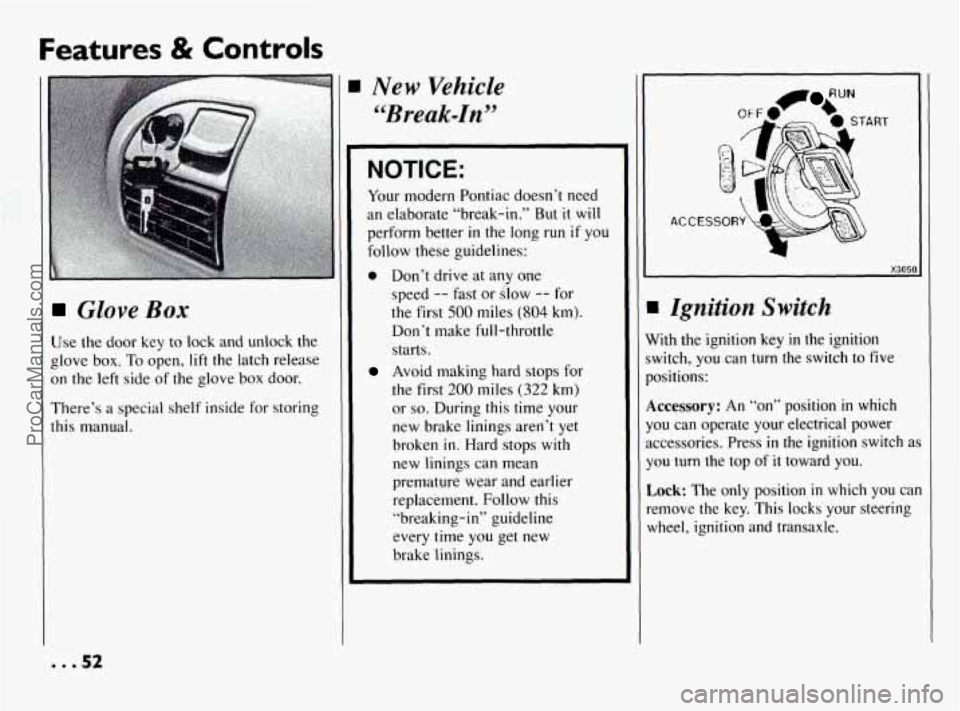
Features & Controls
1 Glove Box
Use the door key to lock and unlock the
glove box.
To open, lift the latch release
on the
left side of the glove box door.
There’s a special shelf inside for storing
this manual.
New Vehicle
“Break-In”
NOTICE:
Your modern Pontiac doesn’t need
an elaborate “break-in.” But
it will
perform better in the long run if you
follow these guidelines:
0 Don’t drive at any one
speed
-- fast or slow -- for
the first
500 miles (804 km).
Don’t make full-throttle
starts.
Avoid making hard stops for
the first 200 miles (322 km)
or so. During this time your
new brake linings aren’t yet
broken in. Hard stops with
new linings can mean
premature wear and earlier
replacement. Follow this
“breaking-in” guideline
every
time you get new
brake linings.
RUN
x305a
I Ignition Switch
Nith the ignition key in the ignition
witch, you can
turn the switch to five
)ositions:
4ccessory: An “on” position in which
’ou can operate your electrical power
Iccessories. Press
in the ignition switch as
rou turn the top of it toward you.
,ock: The only position in which you can
‘emove the key. This locks your steering
vheel, ignition and transaxle.
... 52
ProCarManuals.com
Page 54 of 290
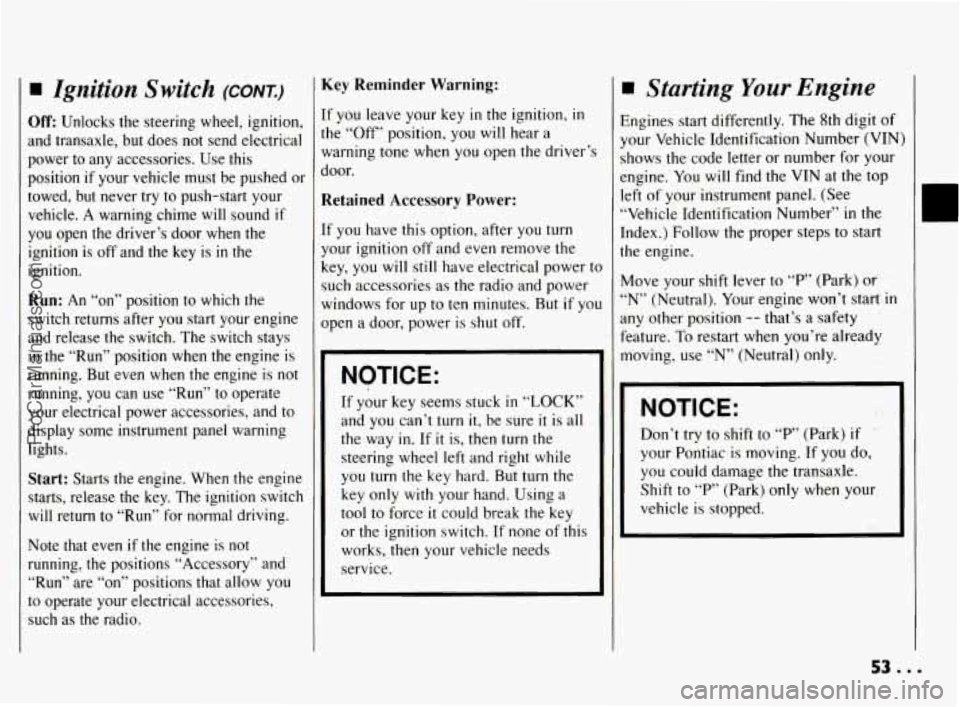
Ignition Switch (CONK)
Off: Unlocks the steering wheel, ignition,
and transaxle, but does not send electrical
power to any accessories. Use this
position
if your vehicle must be pushed or
towed,
but never try to push-start your
vehicle.
A warning chime will sound if
you open the driver’s door when the
ignition is off and the key is
in the
ignition.
Run: An “on” position to which the
switch returns after you start your engine
and release the switch. The switch stays
in the “Run” position when the engine is
running. But even when the engine is not
running, you can use “Run” to operate
your electrical power accessories, and to
display some instrument panel warning
lights.
Start: Starts the engine. When the engine
starts, release the key. The ignition switch
will return to “Run” for normal driving.
Note
that even if the engine is not
running, the positions “Accessory” and
“Run” are “on” positions that allow you
to operate your electrical accessories,
such as the radio.
Key Reminder Warning:
If you leave your key in the ignition, in
the “Off’ position, you will hear a
warning tone when you open the driver’s
door.
Retained Accessory Power:
If you have this option, after you turn
your ignition
off and even remove the
key, you
will still have electrical power to
such accessories as the radio and power
windows for
up to ten minutes. But if you
open
a door, power is shut off.
NOTICE:
If your key seems stuck in “LOCK”
and you can’t turn it, be sure it is all
the way
in. If it is, then turn the
steering wheel left and right
while
you turn the key hard. But turn the
key only
with your hand. Using a
tool to force it could break the key
or the ignition switch. If none
of this
works,
then your vehicle needs
service.
Starting Your Engine
Engines start differently. The 8th digit of
your Vehicle Identification Number (VIN)
shows the code letter or number for your
engine. You
will find the VIN at the top
left of your instrument panel. (See
“Vehicle Identification Number”
in the
Index.) Follow the proper steps to start
the engine.
Move your shift lever to
“P’ (Park) or
“N” (Neutral). Your engine won’t start in
any other position -- that’s a safety
feature. To restart when you’re already
loving, use
“N” (Neutral) only.
NOTICE:
Don’t try to shift to “P” (Park) if
your Pontiac is moving. If you do,
you could damage the transaxle.
Shift to
“P” (Park) only when your
vehicle is stopped.
ProCarManuals.com
Page 55 of 290
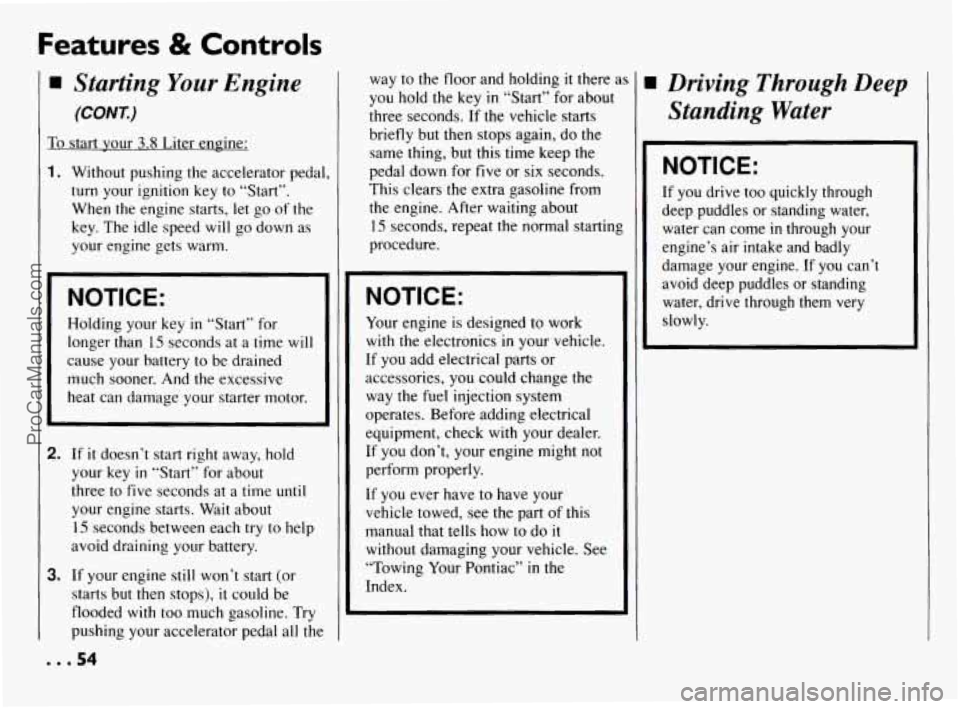
Features & Controls
.
Starting Your Engine
(CONK)
To start your 3.8 Liter engine:
1. Without pushing the accelerator pedal,
turn your ignition
key to “Start”.
When the engine starts,
let go of the
key. The idle speed will go down as
your engine gets warm.
NOTICE:
Holding your key in “Start” for
longer than
15 seconds at a time will
cause your battery
to be drained
much sooner. And the excessive
heat can damage your starter motor.
2. If it doesn’t start right away, hold
your key
in “Start” for about
three to five seconds at a time until
your engine starts. Wait about
15 seconds between each try to help
avoid draining your battery.
3. If your engine still won’t start (or
starts but then stops),
it could be
flooded with
too much gasoline. Try
pushing your accelerator pedal all the
,.a54
way to the floor and holding it there a
you hold the key in “Start” for about
three seconds.
If the vehicle starts
briefly but then stops again, do the
same thing, but this time keep the
pedal down for five or six seconds.
This clears the extra gasoline from
the engine. After waiting about
15 seconds, repeat the normal startin8
procedure.
NOTICE:
Your engine is designed to work
with the electronics
in your vehicle.
If you add electrical parts or
accessories, you could change the
way the fuel injection system
operates. Before adding electrical
equipment, check with your dealer. If you don’t, your engine might not
perform properly.
If you ever have to have your
vehicle towed, see the part of this
manual that tells how
to do it
without damaging your vehicle. See
“Towing Your Pontiac”
in the
Index.
I Driving Through Deep
Standing Water
NOTICE:
If you drive too quickly through
deep puddles or standing water,
water can come
in through your
engine’s air intake and badly
damage your engine. If you can’t
avoid deep puddles or standing
water, drive through
them very
slowly.
ProCarManuals.com
Page 56 of 290
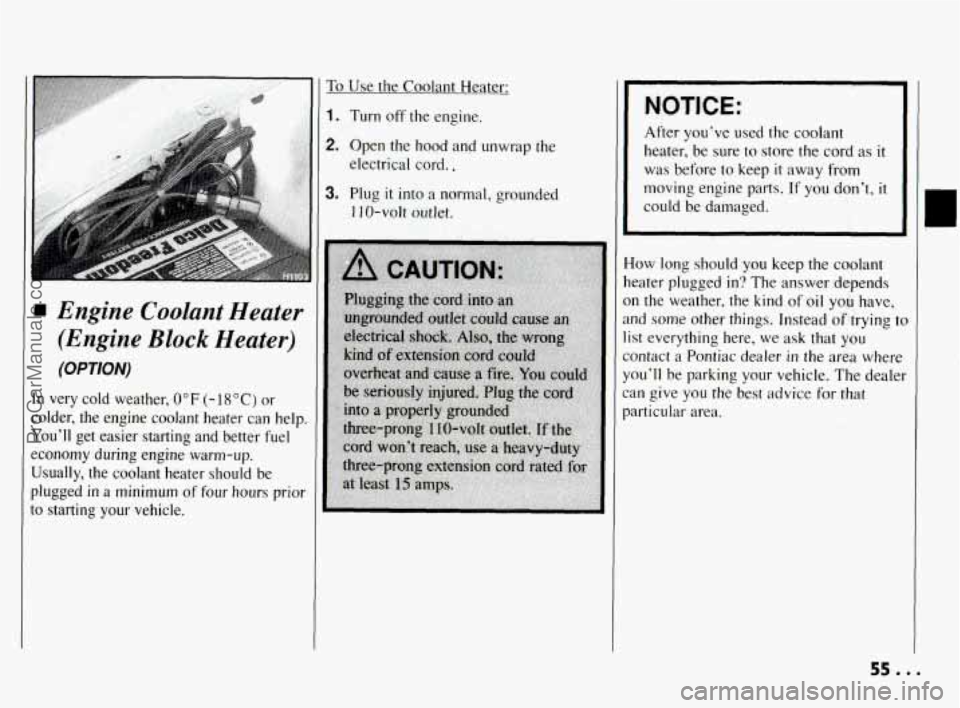
1 Engine Coolant Heater (Engine Block Heater)
(OPTION)
In very cold weather, 0" F (- 18 O C) or
colder, the engine coolant heater can help.
You'll get easier starting and better fuel
economy during engine warm-up.
Usually, the coolant heater should be
plugged
in a minimum of four hours prior
to starting your vehicle.
To Use the Coolant Heater:
1. Turn off the engine.
2. Open the hood and unwrap the
electrical cord.,
3. Plug it into a normal, grounded
110-volt outlet.
NOTICE:
After you've used the coolant
heater, be sure
to store the cord as it
was before to keep
it away from
moving engine parts. If
you don't, it
could be damaged.
How long should you keep the coolant
heater plugged in? The answer depends
on the weather, the kind of oil you have,
and
some other things. Instead of trying to
list everything here, we ask that you
contact a Pontiac dealer in the area where
you'll be parking your vehicle. The dealer
can give
you the best advice for that
particular area.
55.D.
ProCarManuals.com
Page 57 of 290
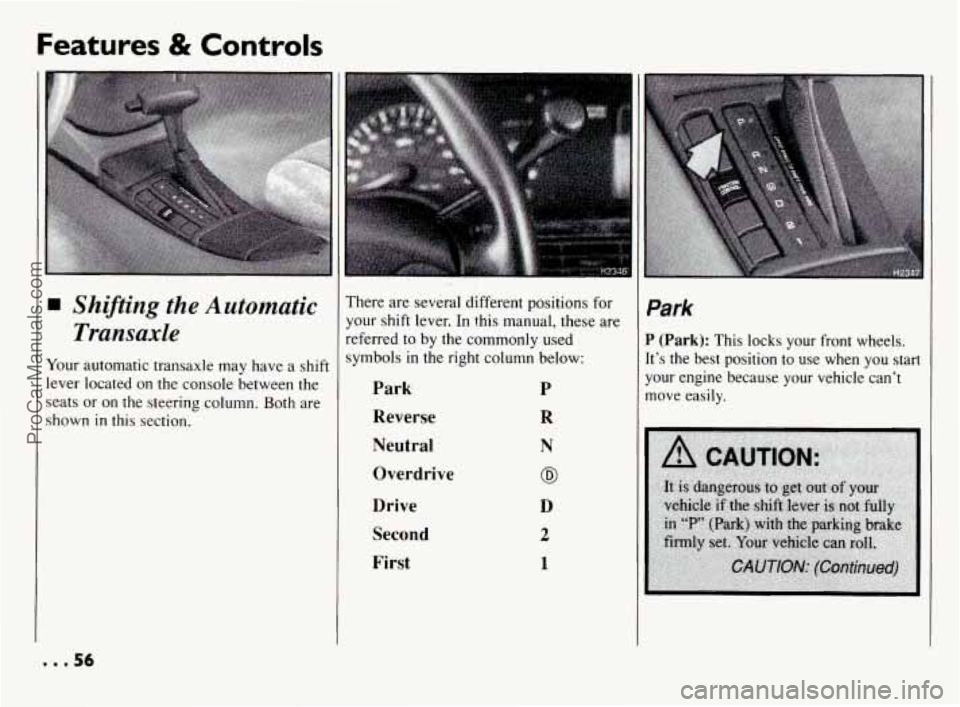
Features & Controls
Shifting the Automatic Transaxle
Your automatic transaxle may have a shift
lever located on the console between the
seats or
on the steering column. Both are
shown
in this section.
1
There are several different positions for
your shift lever. In this manual, these are
referred to by the commonly used
symbols in the right column below:
Park
Reverse
Neutral
Overdrive
Drive Second
First P
R
N
@
D
2
1
Park
P (Park): This locks your front wheels.
It’s the best position
to use when you start
your engine because your vehicle can’t
move easily.
... 56
ProCarManuals.com
Page 58 of 290
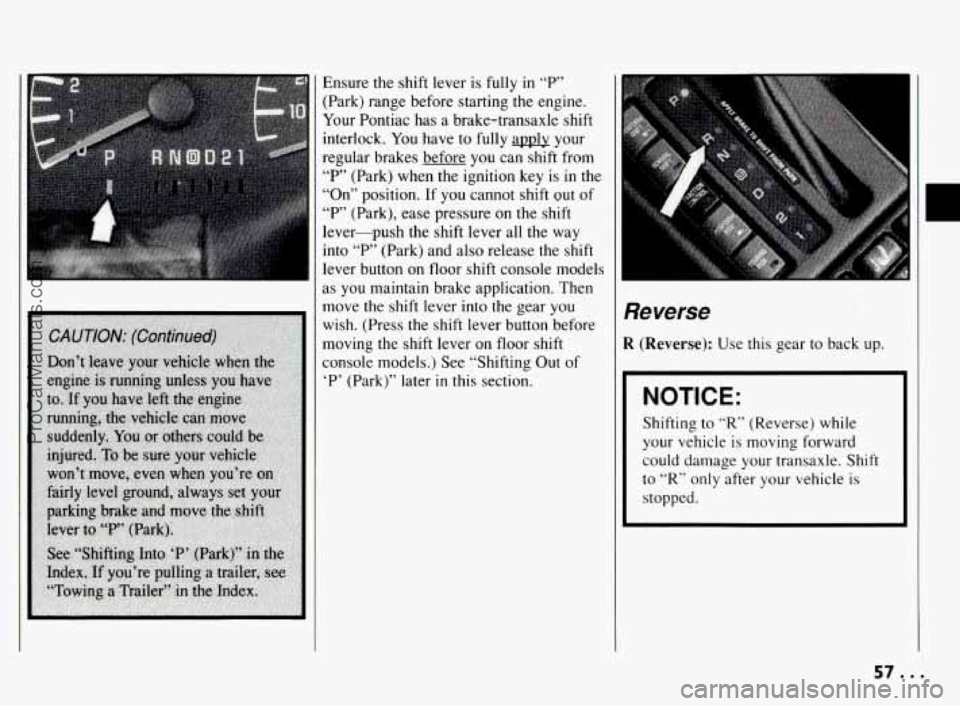
Ensure the shift lever is fully in “P”
(Park) range before starting the engine.
Your Pontiac has a brake-transaxle shift
interlock.
You have to fully apply your
regular brakes before you can shift from
“P,’ (Park) when the ignition key is in the
“On” position. If you cannot shift
gut of
“P’ (Park), ease pressure on the shift
lever-push the shift lever all the way
into
“P” (Park) and also release the shift
lever button on floor shift console models
as you maintain brake application. Then
move the shift lever into the gear you
wish. (Press the shift lever button before
moving the shift lever on floor shift
console models.) See “Shifting Out
of
‘P’ (Park)” later in this section.
Reverse
R (Reverse): Use this gear to back up.
NOTICE:
Shifting to “R” (Reverse) while
your vehicle is moving forward
could damage your transaxle. Shift
to “R” only after your vehicle is
stopped.
57. ..
ProCarManuals.com
Page 59 of 290
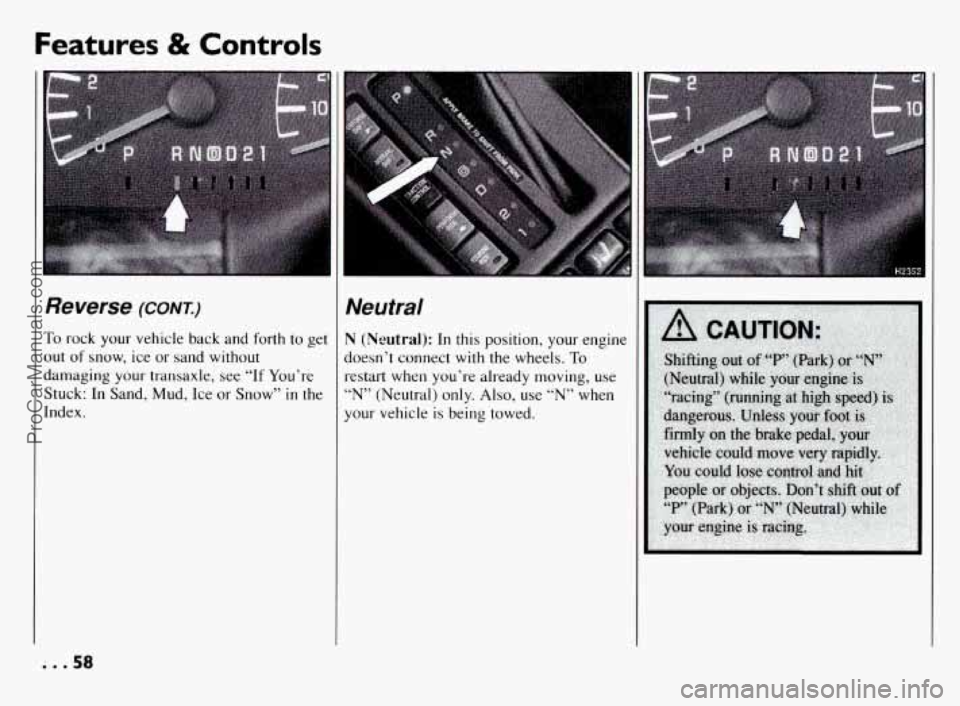
Features & Controls
I
Reverse (CONT.)
To rock your vehicle back and forth to get
out of
snow, ice or sand without
damaging your transaxle, see
“If You’re
Stuck: In Sand, Mud, Ice
or Snow” in the
Index.
Neutral
N (Neutral): In this position, your engine
doesn’t connect with the wheels.
To
restart when you’re already moving, use
“N” (Neutral) only. Also, use “N’ when
your vehicle is being towed.
... 58
ProCarManuals.com
Page 60 of 290
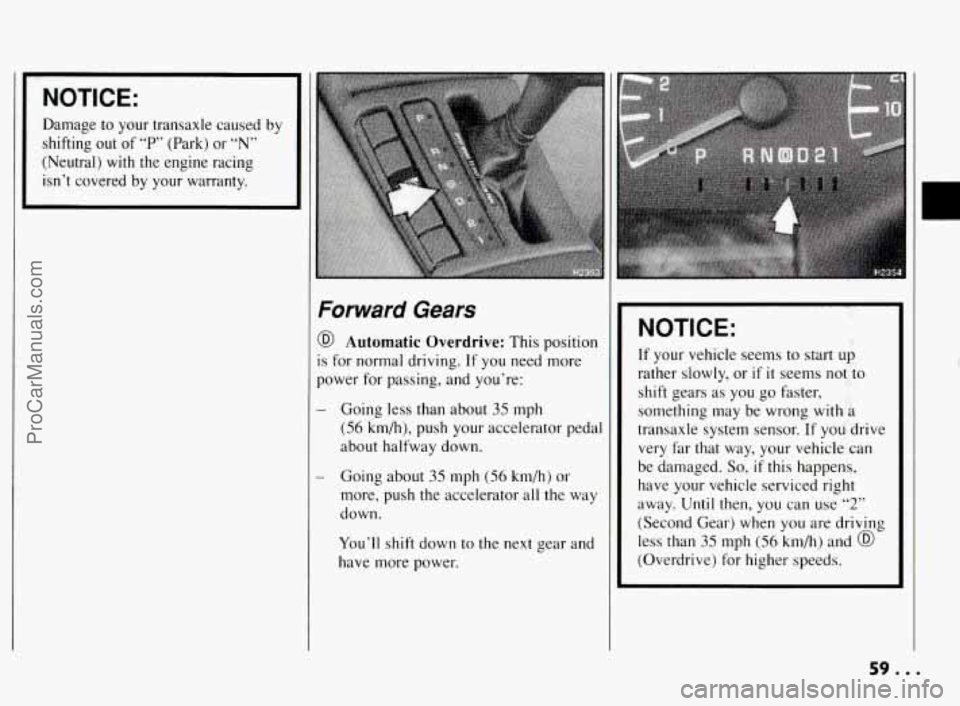
I NOTICE: I
Damage to your transaxle caused by
shifting out of
“P” (Park) or “N”
(Neutral) with the engine racing
isn’t covered by your warranty.
Forward Gears
Automatic Overdrive: This position
IS for normal driving. If you need more
power for passing, and you’re:
- Going less than about 35 mph
(56 km/h), push your accelerator pedal
about halfway down.
- Going about 35 mph (56 km/h) or
more, push the accelerator all the
way
down.
You’ll shift down to the next gear and
have more power.
NOTICE:
If your vehicle seems to start up
rather slowly, or if it seems not to
shift gears as you go faster,
something
may be wrong with a
transaxle system sensor. If
you drive
very far that way, your vehicle can
be damaged.
So, if this happens,
have your vehicle serviced right
away.
Until then, you can use “2”
(Second Gear) when you are driving
less than
35 mph (56 km/h) and @
(Overdrive) for higher speeds.
L
ProCarManuals.com